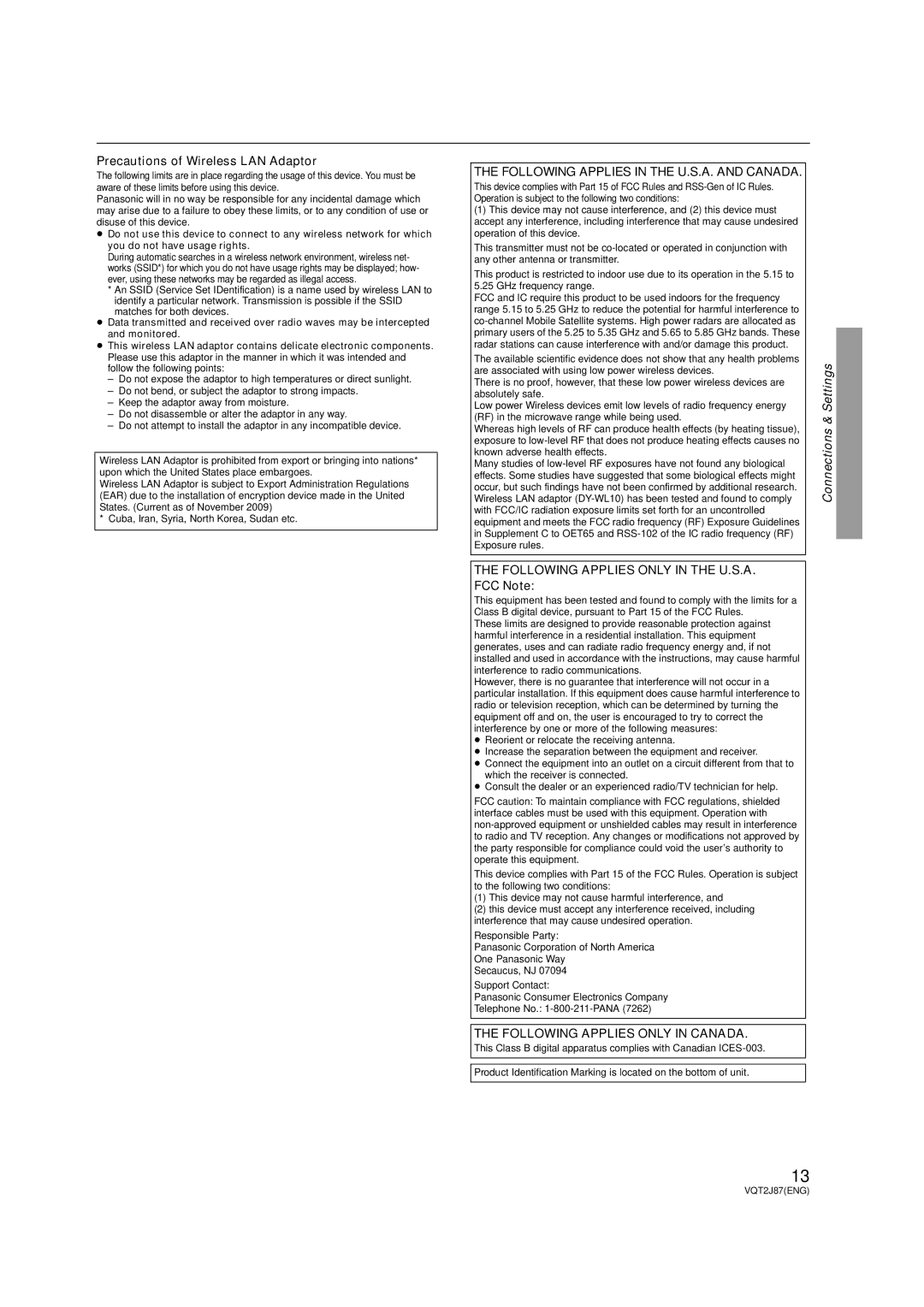
Precautions of Wireless LAN Adaptor
The following limits are in place regarding the usage of this device. You must be aware of these limits before using this device.
Panasonic will in no way be responsible for any incidental damage which may arise due to a failure to obey these limits, or to any condition of use or disuse of this device.
≥Do not use this device to connect to any wireless network for which you do not have usage rights.
During automatic searches in a wireless network environment, wireless net- works (SSID*) for which you do not have usage rights may be displayed; how- ever, using these networks may be regarded as illegal access.
*An SSID (Service Set IDentification) is a name used by wireless LAN to identify a particular network. Transmission is possible if the SSID matches for both devices.
≥Data transmitted and received over radio waves may be intercepted and monitored.
≥This wireless LAN adaptor contains delicate electronic components. Please use this adaptor in the manner in which it was intended and follow the following points:
– Do not expose the adaptor to high temperatures or direct sunlight.
– Do not bend, or subject the adaptor to strong impacts.
– Keep the adaptor away from moisture.
– Do not disassemble or alter the adaptor in any way.
– Do not attempt to install the adaptor in any incompatible device.
Wireless LAN Adaptor is prohibited from export or bringing into nations* upon which the United States place embargoes.
Wireless LAN Adaptor is subject to Export Administration Regulations (EAR) due to the installation of encryption device made in the United States. (Current as of November 2009)
* Cuba, Iran, Syria, North Korea, Sudan etc.
THE FOLLOWING APPLIES IN THE U.S.A. AND CANADA.
This device complies with Part 15 of FCC Rules and
(1)This device may not cause interference, and (2) this device must accept any interference, including interference that may cause undesired operation of this device.
This transmitter must not be
This product is restricted to indoor use due to its operation in the 5.15 to 5.25 GHz frequency range.
FCC and IC require this product to be used indoors for the frequency range 5.15 to 5.25 GHz to reduce the potential for harmful interference to
The available scientific evidence does not show that any health problems are associated with using low power wireless devices.
There is no proof, however, that these low power wireless devices are absolutely safe.
Low power Wireless devices emit low levels of radio frequency energy (RF) in the microwave range while being used.
Whereas high levels of RF can produce health effects (by heating tissue), exposure to
Many studies of
THE FOLLOWING APPLIES ONLY IN THE U.S.A. FCC Note:
This equipment has been tested and found to comply with the limits for a Class B digital device, pursuant to Part 15 of the FCC Rules.
These limits are designed to provide reasonable protection against harmful interference in a residential installation. This equipment generates, uses and can radiate radio frequency energy and, if not installed and used in accordance with the instructions, may cause harmful interference to radio communications.
However, there is no guarantee that interference will not occur in a particular installation. If this equipment does cause harmful interference to radio or television reception, which can be determined by turning the equipment off and on, the user is encouraged to try to correct the interference by one or more of the following measures:
≥Reorient or relocate the receiving antenna.
≥Increase the separation between the equipment and receiver.
≥Connect the equipment into an outlet on a circuit different from that to which the receiver is connected.
≥Consult the dealer or an experienced radio/TV technician for help.
FCC caution: To maintain compliance with FCC regulations, shielded interface cables must be used with this equipment. Operation with
This device complies with Part 15 of the FCC Rules. Operation is subject to the following two conditions:
(1)This device may not cause harmful interference, and
(2)this device must accept any interference received, including interference that may cause undesired operation.
Responsible Party:
Panasonic Corporation of North America
One Panasonic Way
Secaucus, NJ 07094
Support Contact:
Panasonic Consumer Electronics Company
Telephone No.:
THE FOLLOWING APPLIES ONLY IN CANADA.
This Class B digital apparatus complies with Canadian
Product Identification Marking is located on the bottom of unit.
Connections & Settings![]()
13
VQT2J87(ENG)
